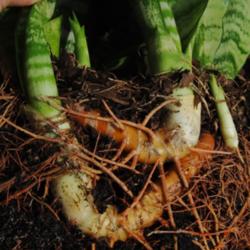The plant shown in the original pics of this discussion is the plain species. Pups propagated from a cut leaf should be identical. it's when they have extra stripes on the sides or other unusual patters that the pattern can't be replicated by propagating leaves (and requires division to preserve.)
Agree that the floppy leaves are likely from insufficient light.
Another possible cause would be if roots are damaged (from being too smashed against each other that rot has occurred, or moisture was unable to penetrate and some part shriveled) and unable to supply moisture to foliage, or there was no moisture available to deliver to foliage. I don't agree at all that plants are "happy being rootbound," especially when it comes to Sansevieria. The roots make large rhizomes and when they are crowded, they must contort and get smushed against each other and the side of the pot:
That can cause difficulties with moisture and oxygen being able to penetrate into the roots, and makes it difficult for the new pups/rosettes to find a spot to emerge from the soil. I do the opposite of the stereotypes about this plant and have never had one die. They grow so fast, I give away boxes of them, and have about 10 rosettes about to bloom. I give the roots plenty of room to roam in a loose/chunky/porous/airy soil, keep them from becoming completely dry, and plenty of light.
No plant likes to be rootbound. What is necessary for plants to stay alive is for their roots to not rot, which can happen so easily in a pot with dense soils, like ground dirt, or bagged mixes of predominantly tiny particles of peat, (or to simply shrivel from simply never getting any water.) Having very little soil around the roots would make the soil dry more quickly, and for even the most dedicated plant-overwaterers to not rot the roots of their plants. This is not ideal, since most non-cactus plants are stressed by dry conditions, it's just a way of coping with soil that has little air in it when moist. Sansevierias are succulent but they are not cactus. When they get loose in warm, moist areas in FL, they grow invasively.
Roots need oxygen & moisture at the same time to function. Just air = shriveling. Just moisture = suffocation & rotting. Either will cause root death and dessicated foliage because the roots have been unable to deliver moisture. Having to let soil dry, as if ones' tropical jungle plant was a cactus, is an unnecessarily stressful coping mechanism for non-desert dwelling plants in soil without enough oxygen for the roots to stay healthy when it is moist and can lead to premature loss of older leaves and in extreme cases, dry shriveled roots/dead plant.
The ability of roots to be able to function properly depends greatly on the soil structure/texture, which can change over time. Potting soil tends to be very dense, mostly peat, with very little air in it. Any kind of organic ingredients decompose into smaller bits over time, and roots fill air spaces over time as they grow through soil. Replacing soil periodically is usually necessary to keep plants healthy because of these reasons. A more porous, chunky, airy soil (like cactus/palm, if one is buying bagged,) can have more air in it even when it is moist because there is space between the particles. When there are tiny particles of any kind in a pot, such as peat, sand, silt, clay, they filter into all of the tiny spaces in a pot, eliminating the air. "Overwatering" is the label and manifestation when roots have suffocated and/or rotted, combo of both. Over time, organic bits decompose into smaller bits, so even the "best" soil, if it has organic components, will need to be replaced when this happens. The speed at which this happens depends on many variables, but on average, about 1-3 years, though in the case of Sansevieria, the roots should fill a pot before the soil turns to mud.
Snake plants are among the easiest house plants you can grow and are one of the best "air cleaners" for indoors too.
I love your plant pot and table, too. Sans are great houseplants that grow easily, even in low light. There are a lot of different ones. Some bloom and have wonderful scents.
